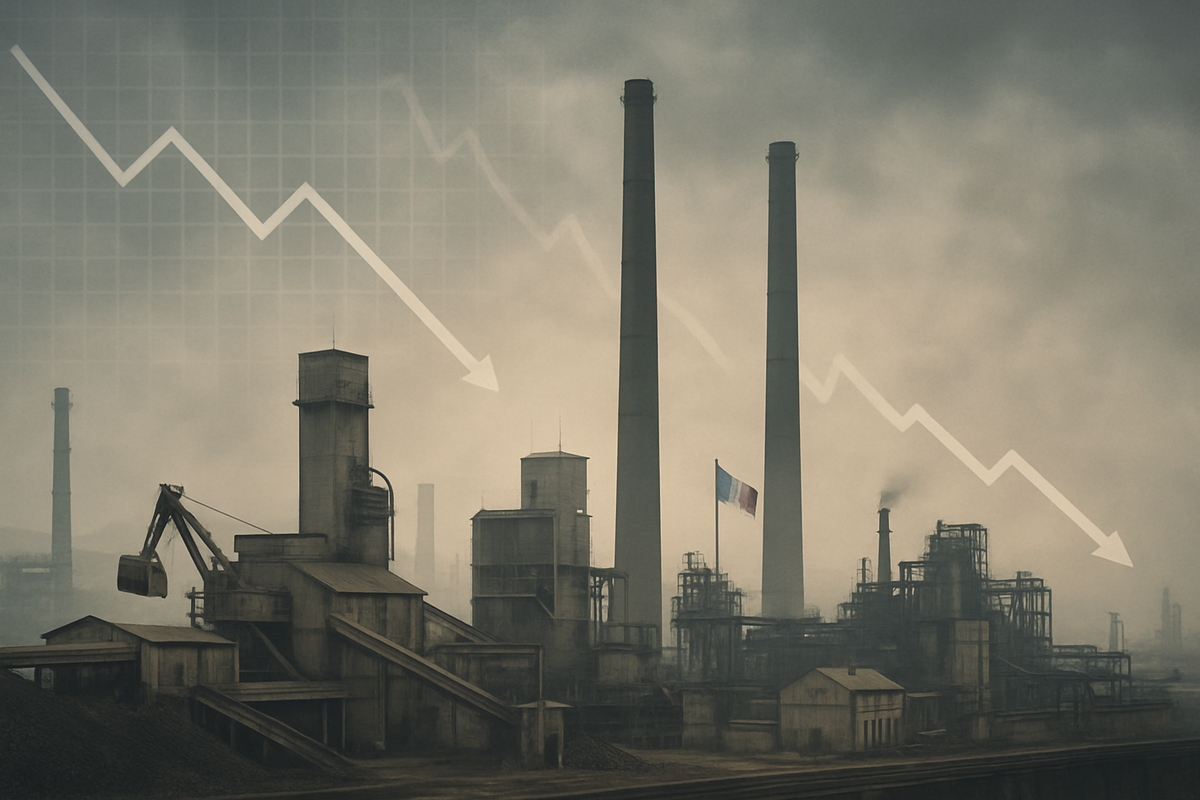
Mexico's industrial sector is facing a challenging period, with recent data revealing a significant and unexpected contraction in output that has sent ripples through financial markets and prompted economists to revise growth forecasts downwards. The sustained decline, particularly noticeable through the summer of 2025, signals a broader economic slowdown that could have lasting implications for the nation's economic trajectory and its key industries.
The disappointing figures underscore a growing fragility in Mexico's manufacturing, mining, and construction sectors, raising concerns about job security, investment confidence, and the overall health of the economy. Investors are closely monitoring the situation, as the unexpected downturn could influence central bank policies and prompt a re-evaluation of Mexico's appeal as a manufacturing hub amid ongoing global economic uncertainties.
A Deep Dive into the Contraction: Figures, Sectors, and Reactions
The National Institute of Statistics and Geography (INEGI) reported a series of concerning figures throughout 2025, painting a clear picture of a sector struggling to gain momentum. In August 2025, industrial production plummeted by 3.6% year-on-year, a steeper decline than the anticipated 2.2% and an acceleration from July's 2.7% slump. Month-on-month, output fell by 0.3% (seasonally adjusted), extending a previous 1.2% decline. This followed a July 2025 contraction of 2.7% year-on-year, marking the fourth consecutive annual drop. Even earlier in the year, June 2025 saw a 0.7% year-on-year decrease, preceded by a 0.8% fall in May 2025. Year-to-date, industrial output has seen a 1.7% drop compared to the same period last year.
The contraction has been alarmingly broad-based, affecting nearly all major industrial components. The mining sector was particularly hard hit, shrinking by a substantial 6.8% year-on-year in August 2025. Construction followed suit with a 4% decline in August, marking a second consecutive month of decreases. Manufacturing, a cornerstone of the Mexican economy, saw a 3.1% year-on-year decrease in August, with critical subsectors like transportation equipment (including light vehicles) experiencing a 4.1% decline in July. Even the utilities sector (electricity, gas, and water supply) registered a 2.2% fall in August.
This sustained downturn has triggered immediate and significant market reactions. Economic analysts, including those from institutions like Banorte (BMV: BANORTEO), have swiftly revised Mexico's economic growth forecasts downwards, indicating a belief that this is a persistent issue rather than a temporary blip. The Mexican stock market is likely to feel the pressure, with sectors heavily reliant on industrial output, such as manufacturing and materials, facing potential headwinds. Moreover, the human cost is evident: the manufacturing industry alone shed approximately 19,000 jobs in July 2025 compared to June, contributing to a total loss of 221,000 jobs in the sector since July 2024.
Adding to the uncertainty are external factors, notably the lingering specter of potential U.S. tariffs on Mexican goods, which were postponed in August but remain a concern, and the ongoing, complex revision process for the USMCA free trade agreement, with formal discussions expected to continue until mid-2026. These trade-related anxieties further cloud the outlook for Mexico's export-oriented manufacturing sector. In response to the economic headwinds, the Mexican government's finance ministry has proposed a significant increase in resources for priority infrastructure projects in its 2026 budget (Ps536.8bn or $29bn), representing a 174% annual increase, signaling a proactive effort to stimulate construction and industrial activity.
Companies on the Brink: Winners and Losers in a Contracting Market
The significant slowdown in Mexico's industrial output is poised to create distinct winners and losers across various sectors, impacting both domestic powerhouses and international corporations with substantial operations in the country. Companies deeply entrenched in the affected industrial segments, such as manufacturing, construction, and mining, are likely to face considerable challenges, while some sectors might demonstrate resilience or even capitalize on shifts in the economic landscape.
In the manufacturing sector, particularly the automotive industry, companies like Nemak (BMV: NEMAK), a major producer of aluminum components for the global automotive industry, could experience reduced demand from assembly plants. Similarly, other auto parts manufacturers and electronics assemblers that rely on export markets, such as those supplying to the United States, might see their revenues and profitability constrained by weaker global demand and potential trade uncertainties. The construction sector, grappling with reduced private investment and delays in public projects, could negatively impact cement producers like Cemex (BMV: CEMEXCPO) and other building material suppliers. Their sales volumes and margins could be pressured by fewer new projects and stalled developments. Companies involved in the mining sector, including state-owned PEMEX, will continue to face headwinds from lower production levels, which could impact their operational efficiency and revenue streams.
Conversely, some companies might prove more resilient or even find opportunities. Businesses with strong domestic demand for essential goods, or those less reliant on the directly impacted industrial sectors, might weather the storm better. For instance, consumer staples companies or those in the services sector not directly tied to industrial production might see more stable performance. Furthermore, companies involved in the government's proposed infrastructure projects, such as construction firms specializing in public works, could potentially benefit from the increased budget allocation. However, the overall sentiment of economic contraction is likely to dampen investor enthusiasm across the board, pushing companies to streamline operations, reduce costs, and explore new markets to mitigate the adverse effects of the industrial slowdown.
Broader Implications: A Shifting Economic Landscape
Mexico's industrial output contraction is not an isolated event; it fits into a broader narrative of global economic deceleration and supply chain realignments that have been unfolding since the post-pandemic recovery. This downturn highlights Mexico's vulnerability to external shocks, particularly its deep economic ties with the United States. The slowdown in U.S. demand, coupled with persistent inflationary pressures and higher interest rates globally, has dampened enthusiasm for new investments and consumer spending, directly impacting Mexico's export-oriented manufacturing sector.
The ripple effects of this contraction are substantial. Competitors in other emerging markets, especially those vying for manufacturing investment, might see an opportunity to attract capital if Mexico's economic outlook continues to falter. Partners within integrated supply chains, particularly U.S. companies that rely on Mexican-produced components (e.g., in automotive and electronics), could face disruptions and increased costs, potentially leading them to diversify their sourcing. Regulatory and policy implications are also significant; the Mexican government might be compelled to implement more aggressive fiscal or monetary stimulus measures beyond the proposed infrastructure spending to avert a deeper recession. The central bank, Banco de México (Banxico), will face a delicate balancing act between controlling inflation and supporting economic growth. Historically, Mexico has experienced similar periods of industrial slowdown, often exacerbated by external economic crises or domestic policy uncertainties. Comparisons to the 2008-2009 global financial crisis or even the early 1990s peso crisis could offer insights into potential recovery pathways, although each situation presents unique challenges. This current contraction underscores the urgent need for Mexico to diversify its economic drivers and strengthen its domestic market resilience.
The Road Ahead: Navigating Uncertainty and Opportunity
Looking ahead, the short-term outlook for Mexico's industrial sector remains challenging, with economists widely anticipating continued weakness through the end of 2025 and into early 2026. The sustained decline in key sectors like manufacturing and construction suggests that a quick rebound is unlikely without significant shifts in global demand or robust domestic stimulus. Short-term possibilities include further downward revisions of GDP forecasts, increased unemployment, and continued pressure on the Mexican peso. However, the government's commitment to substantial infrastructure investment could provide some localized relief, particularly for the construction sector, though its impact on overall industrial output may take time to materialize.
In the long term, Mexico faces critical strategic pivots. Companies operating within the country may need to adapt by focusing on greater automation, supply chain resilience, and exploring new export markets beyond the traditional U.S. focus. The ongoing USMCA review, while a source of near-term uncertainty, also presents an opportunity for Mexico to solidify its position as a reliable trading partner and attract nearshoring investments if it can address concerns about its industrial competitiveness and regulatory environment. Potential market opportunities could emerge for companies that innovate in areas of energy efficiency, sustainable manufacturing, or those that cater to a growing domestic middle class. Scenarios range from a gradual, slow recovery, potentially spurred by a stronger global economy in late 2026, to a more prolonged period of stagnation if underlying structural issues and external headwinds persist. Investors will be keenly watching for signs of stabilization in industrial data, government policy effectiveness, and the resolution of international trade uncertainties.
Wrap-Up: A Test of Resilience for Mexico's Economy
Mexico's unexpected industrial output contraction represents a significant test of the nation's economic resilience. The key takeaways from this event are clear: a broad-based slowdown is underway, impacting critical sectors and leading to job losses and downward revisions in economic growth forecasts. This contraction is not merely a statistical anomaly but a reflection of deeper challenges stemming from weakened domestic and international demand, persistent inflationary pressures, and ongoing geopolitical and trade uncertainties.
Moving forward, the market will remain highly sensitive to incoming economic data, particularly industrial production figures, employment reports, and inflation readings. The effectiveness of the government's proposed infrastructure spending in stimulating activity will be a crucial factor to monitor. Investors should also pay close attention to the central bank's monetary policy decisions, as Banxico navigates the complex task of supporting growth while maintaining price stability. The lasting impact of this slowdown could reshape Mexico's industrial landscape, potentially accelerating diversification efforts and prompting a re-evaluation of its role in global supply chains. For investors, the coming months will require a discerning eye, focusing on companies with strong balance sheets, diversified revenue streams, and a clear strategy to adapt to a more challenging economic environment. The period ahead will undoubtedly reveal the true strength and adaptability of Mexico's economy.
This content is intended for informational purposes only and is not financial advice

















